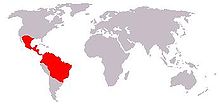Coati
| Coati | |
|---|---|
 |
|
| White-nosed coati (Nasua narica) | |
| Scientific classification | |
| Kingdom: | Animalia |
| Phylum: | Chordata |
| Class: | Mammalia |
| Order: | Carnivora |
| Family: | Procyonidae |
| Genus: | Nasua and Nasuella |
 |
|
| Range map | |
The coati, genera Nasua and Nasuella, also known as the Coati-Mundi or coatimundi /koʊˌɑːtᵻˈmʌndi/,hog-nosed coon, Mexican tejón, cholugo, or moncún, Guatemalan and Costa Rican pizote, Colombian cusumbo, and other names, is a member of the raccoon family (Procyonidae), a diurnal mammal native to South America, Central America, and south-western North America. The term is reported to be derived from the Tupi language of Brazil.
Adult coatis measure 33 to 69 cm (13 to 27 in) from head to the base of the tail, which can be as long as their bodies. Coatis are about 30 cm (12 in) tall at the shoulder and weigh between 2 and 8 kg (4.4 and 17.6 lb), about the size of a large house cat. Males can become almost twice as large as females and have large, sharp canine teeth. The above measurements are for the white-nosed and South America coatis. The two mountain coatis are smaller.
All coatis share a slender head with an elongated, flexible, slightly upward-turned nose, small ears, dark feet, and a long, non-prehensile tail used for balance and signaling.
Ring-tailed coatis have either a light brown or black coat, with a lighter under-part and a white-ringed tail in most cases. Coatis have a long brown tail with rings on it which are anywhere from starkly defined like a raccoon's to very faint. Like raccoons and unlike ring-tailed cats and cacomistles, the rings go completely around the tail. Coatis often hold the tail erect; it is used as such to keep troops of coatis together in tall vegetation. The tip of the tail can be moved slightly on its own, as is the case with cats, but it is not prehensile as is that of the kinkajou, another procyonid.
...
Wikipedia
